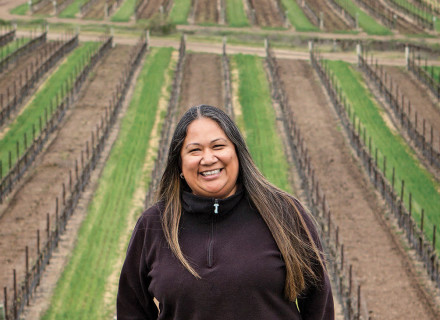The majority of British Columbia’s vineyards are in a dynamic wine region little-known outside of Canada.
The six geographic indications (wine regions) of the Okanagan Valley bear 84 percent of British Columbia’s vineyard acreage. From Kelowna, where in 1859 the province’s first grapevines were planted by Father Charles Pandosy, to Osoyoos, a semi-arid climate zone notable for its red wines, the Okanagan is dotted with vineyards and wineries. Some of them are owned and operated by Indigenous Canadians, but all are ripe for enjoyment by western oenophiles in search of fruit off the beaten path. “The beauty of the rolling vineyards set above the lakes and the unique hot, dry climate with its clear skies and cool nights to preserve natural acidity in the wines make the Okanagan one of the world’s most stunning wine regions to visit,” says Laura Kittmer of the British Columbia Wine Institute. And, after a summer trip to the area, we couldn’t agree more. Here is a trio of our favorite Okanagan wineries.
Indigenous World Winery
Region: Kelowna
Established: 2016
Munch to match: A seasonal tartare dish with 2016 Indigenous La’p Cheet
Indigenous World Winery rolls down from a ridge looking over Okanagan Lake, popular with boating and skiing enthusiasts. From the main building, which houses a tasting room, shop, and the Red Fox Club restaurant, visitors can sip on a glass of red Simo (translated to “connected to the land” from the Okanagan Syilx language) or cool-climate Ehrenfelser, which the folks at Indigenous World call “a great patio wine.” The vineyard, like all of the Okanagan, sits parallel in latitude with France’s Champagne region. Little wonder that when asked what wine and dish she would pair to reflect its position, Red Fox Club executive chef Andrea Callan reached for the bubbly and a tartare. “I would choose our seasonal tartare dish with raw fish or meat mixed with fresh herbs and complementary vinaigrettes with foraged finds on large flat stones instead of plates,” she says. “I love bubbles, and our 2016 Indigenous La’p Cheet sparkling rosé is a perfect pairing for such a dish.” As nice as it is to note the region’s similarity to a famed European wine destination, the Okanagan is known for its micro-climates and varying soil compositions. It has more to offer than sparkling wines. Take the 2016 Muscat (made with orange muscat, black muscat, and muscat ottonel), a dry white that plays well with Saskatoon berry mustard and smoked mackerel. Combined on the fork, they’re a prickly hot pair. But matched against the Muscat, the spice cuts into a swish of light heat with peaks of sweetness. 2218 Horizon Drive, Kelowna, B.C., indigenousworldwinery.com
Nk’Mip Cellars
Region: Osoyoos
Established: 2002
Munch to match: a cedar plank-smoked salmon served over wild rice and roasted root vegetables and finished with a simple butter sauce with 2016 Qwam Qwmt Chardonnay
In the heart of the Osoyoos, Nk’Mip (pronounced “in-ka-meep”) began life in 1968 at Inkameep Vineyard in nearby Oliver. It wasn’t until 1998 that Nk’Mip Cellars planted vines at the winery location in Osoyoos. “Knowing that it takes approximately four years before the quality of grapes is at the level for making quality wine,” says Nk’Mip Cellars winemaker Randy Picton, “we decided to plant the vineyard before building the winery.” The patience paid off. One of the first vintages, the 2002 Qwam Qwmt Chardonnay (“achieving excellence” in the Okanagan language), won a gold medal at the 2004 J. Mead New World International Wine Competition. The 2016 Qwam Qwmt Chardonnay is another winner, taking home the gold at this year’s Chardonnay-du-Monde competition in Burgundy, France. Picton recommends pairing the 2016 vintage with a classic cedar plank-smoked salmon served over wild rice and roasted root vegetables and finished with a simple butter sauce. That being said, Osoyoos is better known for producing full-bodied red grapes like merlot, cabernet sauvignon, and syrah, and that’s where Picton and his team focus their premium line’s building blocks. From that, Nk’Mip creates its signature wine, Mer’r’iym Red Meritage, a red Bordeaux blend of cabernet sauvignon, merlot, malbec, and cabernet Franc. As Picton puts it: “In the Okanagan language, Mer’r’iym means “marriage,” which is exactly what we are aiming to create by blending these varieties — a perfect marriage of grapes.” 1400 Rancher Creek Road, Osoyoos, B.C., nkmipcellars.com
Le Vieux Pin
Region: Oliver, “Wine Capital of Canada”
Established: 2005
Munch to match: Peppercorn crusted flank steak with cuvee classique
The only non-100 percent Indigenous-owned winery featured here, Le Vieux Pin, which released its first vintage in 2005, specializes in the dark and brooding personalities of syrah that belie its guarded, easygoing character. It’s as distinctive as the Okanagan Valley. “The Okanagan Valley has huge diurnal temperature differences,” says Rasoul Salehi, a managing partner at Le Vieux Pin. “Hot days and cold nights give us both exuberant and lush fruit, yet elegant tannins, great natural acidity, and balanced alcohol.” In a nod to this variety, the micro-climates and the soil diversity, Le Vieux Pin showcases cuvées (blends) of syrah. Cuvée Violette highlights the perfumed and floral side of syrah. Cuvée Classique reveals the masculine, spicy, savory side of syrah, while Cuvée Equinoxe strikes a syrah balance. 5496 Black Sage Road, Oliver, B.C., levieuxpin.ca
Photography: winebc.com.
From the October 2018 issue.
Subscribe to the forthcoming monthly Taste of the West e-newsletter below.

















